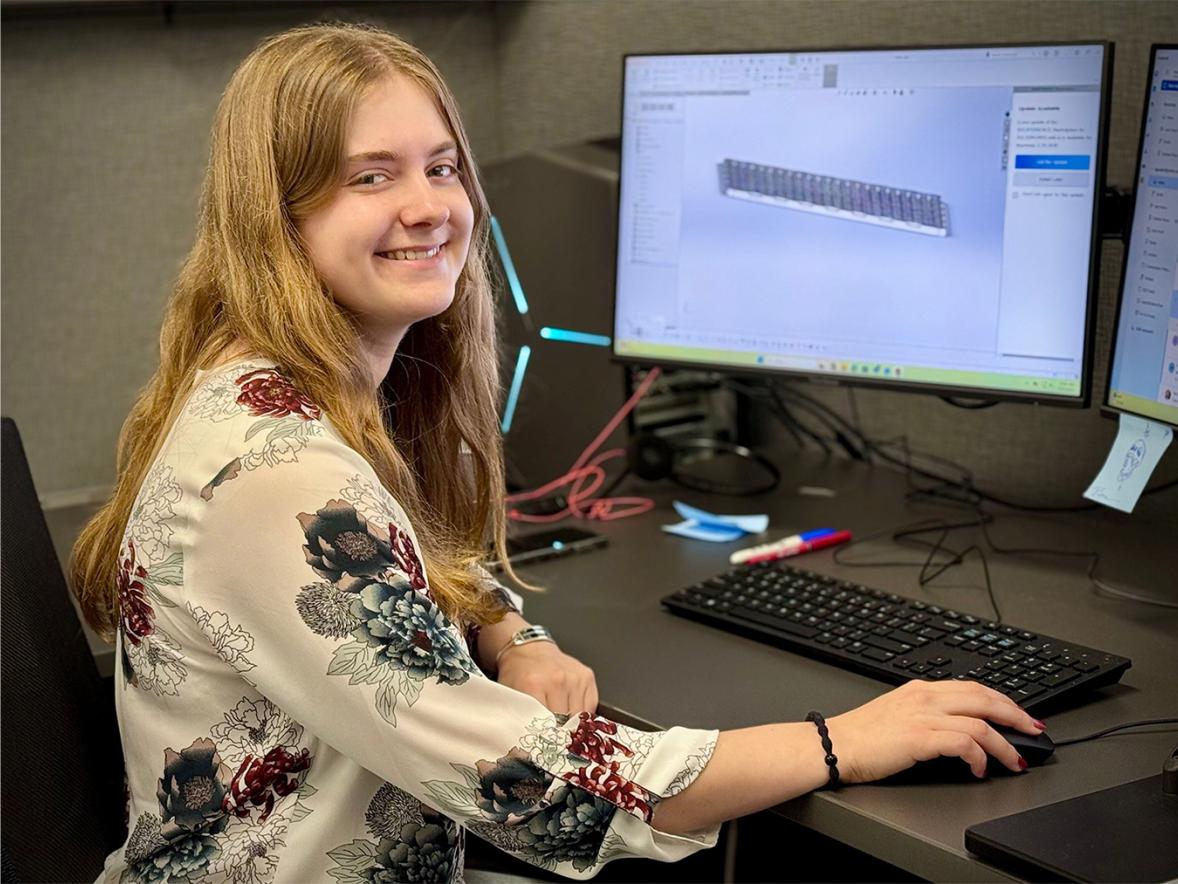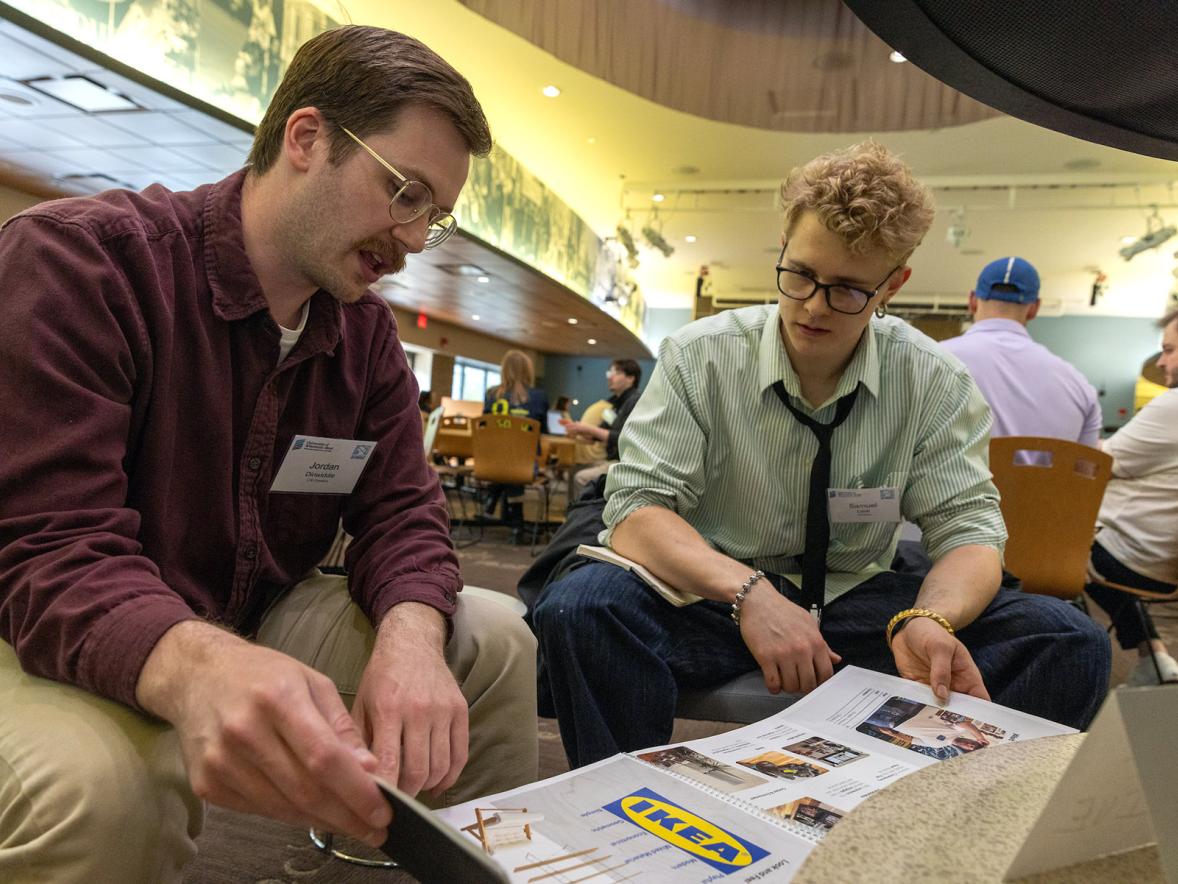Summer is approaching, and that means vacation time, with many Americans opting to camp in the great outdoors. And while camping offers a sense of freedom in nature, it often includes adapting to limited living quarters, including learning how to prepare and cook a proper meal.
This spring, UW-Stout industrial and product design students in an Ergonomics class developed kitchenette solutions for the Road Toad trailer, made by Camp-Inn, a leader in the niche market of compact teardrop travel trailers.
“Within our Ergonomics lessons, we look at different sized workspaces, such as the kitchen space in the trailer, to understand the human body and its full body movement in a limited space,” said Associate Professor David Richter-O’Connell. “The purpose of this project was for the students to be creative and have fun.”
Camp-Inn, located in Necedah, supported the project by lending Richter-O’Connell’s class a Road Toad model. The teardrop trailer, with a sleeping cabin that holds a queen-sized bed, offers storage space for gear and a kitchen area accessible from the outside rear of the trailer.
‘Projects having a real-world application’
The trailer was loaded into the hallway of the Applied Arts Building – an interesting temporary installation with a length of 11 feet 2 inches and a width of 60.5 inches for the students to reference during their two-week-long project.
Twenty-three students working in five groups designed kitchen spaces that needed to be geared toward a couple of retirement age or a young family. They researched personas, national camping data and created a multiday meal menu, with food, beverages and kitchen items needing storage, refrigeration and cooking.
They also needed to include a water supply and possible electrical supply, cooking surfaces, food preparation areas, and cleanup spaces, while paying attention to food safety and sanitation.

“In my college days, I remember working on projects that had a real-world application. Those projects gave me a chance to apply the engineering principles I learned in class. They verified the choice of my major and gave me confidence that I could be successful in my chosen profession,” said Craig Edevold, Camp-Inn owner and co-founder.
“I wanted to pass along a similar opportunity to UW-Stout students. I was pleased that the Ergonomics students are in their sophomore year. They are early enough in their college education that this experience may help motivate them in their studies and career,” he added.
Richter-O’Connell’s class has worked with Camp-Inn in past semesters, using the company’s floor plans as defined workspaces, and Edevold enjoyed seeing the students’ ideas and efforts, he said.
The Road Toad already has a complete kitchen solution. The model loaned to the class was a prototype designed for Camp-Inn employees.
New generations bring new innovations to camping
The Camp-Inn brand targets an older demographic: early retirees and empty nesters, who have more available time and more disposable income. About 98% of customers are over 55 years old. The Road Toad camper was designed about five years ago and was built as a lower priced, entry-level trailer.
“We anticipated that it would attract a younger demographic, due to its lower cost and lower maintenance. Its small size and light weight make it ideal for smaller tow vehicles, including hybrids and electrics. However, Road Toad trailers have resulted in less of an increase in younger customers than anticipated,” Edevold said.
“As a result, I wanted to see what expectations a younger generation would have in a camping trailer. What do they value in a camping experience? Do they value different features than the older generation?” he added.
The first student team to present their kitchenette mockup was:
- Britton Bernhard, of Prescott
- Mackenzie Bruesewitz, of Hammond
- Charlie Kalas, of La Crosse
- Lauren Mescher, of New Berlin
- Darik Moilien, of Westby
“This project was a fantastic way to understand how people interact with products within their environment and make the best use of space given the Road Toad's sizing constraints,” Bernhard said. “I really appreciate Road Toad and Professor DROC for giving us the opportunity to work with the camper and push us to design the best possible kitchen or product for ergonomics and style.”
In their research, the group found that the number of camping reservations is increasing across the country, with a high number of millennials represented, and that one-third of families find camping with children to be more relaxing than other vacations.
Based on these demographics, they crafted a persona of a young father and his daughter. The father-character enjoyed the outdoors, including hunting and fishing, and wanted to introduce his child to camping.
The group’s menu included six meals popular with kids, including mac-n-cheese, SpaghettiOs, a breakfast with eggs, bacon and applesauce pouches, and foraged berries for snacks.
Their kitchenette mockup, built with cardboard, featured a power generator, a pull-out gas stove, a pull-out table with adjustable legs, extendable countertops for additional workspace, a dumpable sink with handles, a pull-out dishrack and storage for dishes, a cooler drawer, secured drawers with safety latches, a fold-away canopy, insect-repellent lighting, chairs and additional storage cubbies.
Their digital portfolio included materials such as wood, aluminum, tweed fabric, fiberglass, and a color palette that reflected the soft tones of a forest. They also offered ergonomic views, showing how the kitchenette space would allow for comfortable movements for people ranging in height from 4 feet 11 inches to 6 feet 3 inches tall.
After reviewing the five groups’ project submissions, Edevold saw how different generations have similar wants and needs in the kitchen area of a camping trailer.
“I liked many of the ideas to pull out or extend the work surfaces outside of the trailer body. This enlarges the workspace, allowing room for a second cook or a helper,” he said. “I also liked the ideas of mounting items to the inside of the hatch to easily access those items and move them out of the way, with no added effort.”

Edevold added that he observed generational differences in preferences for a power supply and Wi-Fi availability, explaining that his experience has shown him that older generations use camping to disconnect from electronics and entertainment.
“From this project, it is apparent that younger generations plan to bring electronics with them,” he said. “In the past few years, both the Camp-Inn and Road Toad lines have seen an increase in requests for solar panels, lithium batteries and portable power stations. Generation X and the tail end of the Baby Boomers are more tech-savvy than the earlier Baby Boomers. The desire to bring along more electronics would explain this trend.”
The industrial and product design program is part of the School of Art and Design, one of the largest public art schools in the Midwest. It also offers bachelor’s degrees in animation and digital media; fashion design and development; game design and development-art; graphic design and interactive media; illustration; interior design; studio art; arts administration and entrepreneurship; fashion design and development; and video production, as well as an M.F.A. in design. UW-Stout also has a new program in game and media studies.






